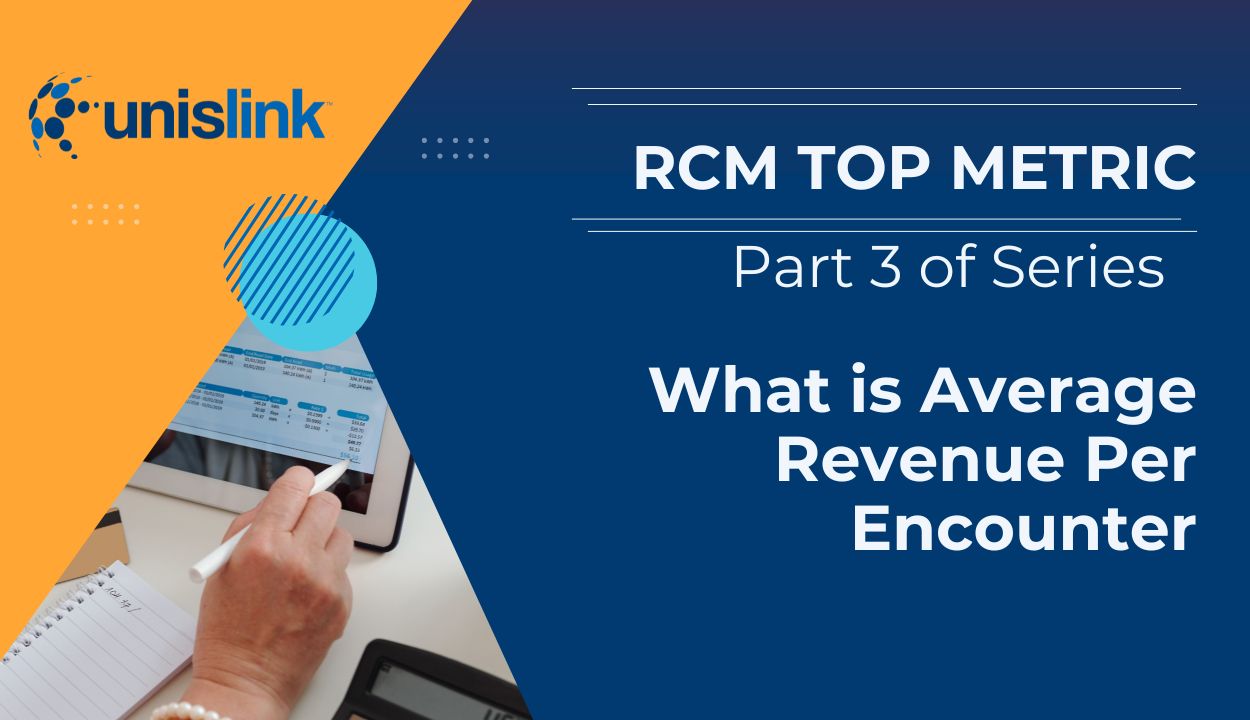This article covering Average Revenue Per Encounter is Part 3 in our series on Tracking Top RCM Metrics:
Part 1: Seven Most Important RCM Metrics That Every Medical Practice Should Monitor
Part 2: How to Improve Cash for Your Medical Practice by Tracking Days in A/R
Part 4: How to Calculate Your Denial Rate and Reduce Denied Claims
Part 5: Monitoring Gross Collection Rate, Revenue Realization Rate, and Net Collection Rate
Financial performance is foundational to the long term stability of a healthcare organization. For any medical practice, understanding how much revenue is generated per patient visit is one of the most revealing key performance indicators of overall financial health.
One of RCM’s Most Important Metrics is Average Revenue Per Encounter (ARE)
ARE is a key performance indicator (KPI) that delivers valuable insight into the true revenue your healthcare facility earns per visit. It reflects the effectiveness of your medical billing, your coding accuracy, insurance company contracts, and revenue cycle management (RCM) strategy.
When tracked over time, ARE can help your team pinpoint inefficiencies, missed revenue opportunities, or troubling downward trends—before they threaten your cash flow.
In this article, we’ll break down what ARE is, why it matters, what operational issues may cause it to decline, and how to improve this important financial metric for a stronger, more sustainable medical practice.
What Is Average Revenue Per Encounter (ARE)?
ARE measures the average amount of revenue a healthcare provider collects for each patient visit, regardless of the charges billed. It’s not about how much you bill—it’s about how much you actually collect.
This makes ARE one of the most truth-telling revenue cycle metrics for any healthcare organization. It shows the effectiveness of your insurance company reimbursements, patient collections, and overall RCM best practices.
Formula for ARE:
Total Revenue Collected ÷ Total Number of Patient Encounters
Example:
Let’s say your medical practice generated $90,000 in revenue last month from 600 patient visits. Your ARE would be:
$90,000 ÷ 600 = $150 per encounter.
This means that, on average, each visit brings in $150 of actual collected revenue—a valuable insight into your practice’s revenue efficiency.
Why ARE Is Important for Healthcare Providers
Tracking ARE monthly provides both a snapshot and a trendline of your healthcare revenue cycle performance. While other KPIs like Days in A/R or Net Collection Rate reveal how well you manage cash flow, Average Revenue Per Encounter tells you how much revenue you’re actually earning per unit of care.
Here’s why ARE matters:
1. Identifies Gaps in Medical Billing or Coding
If your coding is incomplete or inaccurate, your revenue per encounter will drop, no matter how many patients you see. ARE can act as a flag for potential underbilling or missed opportunities for reimbursement.
2. Reveals Issues with Payer Mix
The types of insurance plans your patients carry—commercial, Medicare, Medicaid—affect how much you get paid. A drop in ARE may suggest that your payer mix has shifted toward lower-paying insurance companies.
3. Highlights Operational Inefficiencies
If two providers within your practice see the same number of patients but generate very different ARE figures, that’s a signal to review workflows, documentation, or coding habits.
4. Connects Revenue to Patient Care
When ARE is too low, it can strain your practice’s resources, limit reinvestment in staff, technology, and patient care, and make it harder to deliver quality services.
Industry Benchmarks for ARE
Unlike other KPIs, there’s no universal ARE benchmark because the average revenue per encounter depends heavily on your specialty, the complexity of procedures, and regional payer contracts.
For example:
A primary care practice may see an ARE of $120–$160.
A cardiology group may expect $300–$500.
A behavioral health clinic may average around $100.
What matters most is trending:
If your ARE has dropped by 10% over the last 6 months, it’s time to investigate.
If your ARE is consistently below your specialty benchmark, your practice may be leaving money on the table.
Common Causes of Low Average Revenue Per Encounter
A declining or consistently low ARE is often a symptom of deeper revenue cycle issues. Here are the most common causes:
1. Inaccurate or Incomplete Medical Coding
If diagnosis or procedure codes are missing, incomplete, or not updated to reflect recent changes, it can result in lower reimbursement or claim denials.
2. Suboptimal Payer Contracting
Contracts with insurance companies that reimburse at below-market rates can drag down your average revenue. If you’re not renegotiating contracts periodically, you may be stuck with outdated terms.
3. Poor Documentation
Physicians and clinical staff may not be documenting services thoroughly, leading to downcoded claims or services that aren’t reimbursed at all.
4. High Denial Rates
If a large percentage of claims are denied and not appealed or corrected promptly, revenue losses add up quickly. This reduces the average collected per encounter—even if visit volume remains high.
5. Changes in Payer Mix
A shift from commercial payers to Medicare, Medicaid, or uninsured patients can significantly reduce ARE, even if the number of encounters remains stable.
6. High Patient Responsibility and Low Collections
If you’re not collecting co-pays, deductibles, or balances at the point of service, patient accounts age and revenue is delayed or lost.
How to Improve Your Average Revenue Per Encounter
Your ARE can be improved. Here’s how to lift this critical RCM metric and improve your practice’s financial performance:
1. Perform Regular Coding Audits
Ensure that your medical coding accurately reflects the complexity and scope of care provided. Invest in training your healthcare professionals and billing teams or outsource with a medical billing company that offers accurate coding by certified medical coders.
2. Optimize Documentation Practices
Train providers to document with medical necessity and payer-specific requirements in mind. Use templates or EHR prompts to guide complete documentation without sacrificing efficiency.
3. Analyze Your Payer Mix
Use data analytics to regularly assess your patient population and contracts. Are certain insurance companies underpaying? Are you accepting plans that reimburse too little? Use this analysis to renegotiate contracts or re-evaluate network participation.
4. Improve Point-of-Service Collections
Use real-time insurance verification and estimation tools to calculate patient responsibility and collect balances upfront before the visit. Offer digital payment options to improve compliance and convenience for collecting. Patient experience matters and patients enjoy getting complete information about their balances up front and on a timely basis.
5. Track and Trend ARE Monthly
Use a data-driven dashboard to track ARE across your practice by:
- Provider
- Location
- Insurance Company/Payer
- Specialty: This lets you identify performance gaps and take corrective action faster.
6. Partner with a Revenue Cycle Management Company
Working with an RCM partner gives your practice the tools, data, and billing support to improve ARE without increasing your internal workload.
Using ARE to Make Data-Driven Decisions
Analyze your ARE data with these other Top 7 RCM Metrics to ensure your revenue cycle KPIs meet the standards expected in a high performing medical practice:
- Days in A/R
- A/R Over 120 Days
- Denial Rate
- Gross Collection Rate
- Revenue Realization Rate
- Net Collection Rate
Together, these indicators above give you a comprehensive view of the financial health of your healthcare organization—and the roadmap to improvement.
For example:
- If ARE is dropping and your denial rate is rising, focus on claims management and coding accuracy.
- If ARE is flat but patient volumes are increasing, you may have a payer mix or service pricing issue.
UnisLink is the Medical Billing Company that Can Help You Raise Your Revenue Per Encounter
Improving your Average Revenue Per Encounter (ARE) requires more than just better data—it takes a system-wide approach to strengthening every step of the revenue cycle. That’s where UnisLink delivers.
As a trusted partner to healthcare providers and medical practices nationwide, UnisLink offers a comprehensive suite of revenue cycle management services designed to improve cash flow, reduce operational burdens, and maximize reimbursement for every patient encounter.
UnisLink Strategies to Optimize Your Collections and Increase Your ARE
Eligibility Verification: As your team is booking a patient visit, we verify insurance coverage in real-time. This reduces denials, accelerates claims processing, and ensures patients are informed of their financial responsibility up front.
Accurate eligibility verification supports better payment outcomes and minimizes the risk of unpaid balances, plus it improves patient satisfaction.
Medical Coding: Our team of certified medical coders ensures accurate, compliant, and specialty-specific coding for every encounter. Proper coding is essential to maximizing ARE—it ensures that you’re reimbursed for all services rendered and prevents costly denials due to documentation mismatches or undercoding. We have coding expertise in over 70 specialties with deep experience in coding for all types of physician practices.
Claims Edits & Scrubbing: We run each claim through advanced claims editing software to catch errors before submission. Our scrubbing process checks for missing modifiers, coding inconsistencies, and payer-specific formatting—reducing rejections and improving first-pass resolution rates.
Claim Submission: Clean claims are submitted electronically within 24 hours of service. Our automated processes and payer connectivity speed up reimbursements and minimize bottlenecks in your healthcare revenue cycle.
Insurance Follow-Up: We don’t just submit claims and hope for the best. Our team actively monitors claim status and follows up with insurance companies to ensure timely payment. If delays or discrepancies arise, we act quickly to resolve them—so you don’t lose revenue.
Denials Management: Claim denials are investigated, corrected, and refiled as part of our structured denial management process. We track the root cause of every denial to prevent future occurrences, ensuring that your medical practice doesn’t miss out on collectable revenue due to recurring errors.
Payment Posting: Accurate and timely payment posting is essential for maintaining up-to-date financial records and KPI reporting. We post payments daily and reconcile them against remittance advice, giving your team real-time visibility into collections and outstanding balances.
Patient Statements (Print & Electronic): We generate clear, easy-to-understand patient statements via both print and electronic formats. These statements are designed to improve transparency, reduce confusion and phone calls, and encourage prompt payments.
Patient Collections: Our team manages early-stage patient collections with tact and professionalism. We use a patient-friendly approach that includes reminders, digital payment options, and follow-ups that encourage resolution—without damaging your patient relationships.
Why UnisLink? Your Revenue Improvement Strategy
When you partner with UnisLink, you’re not just getting outsourced billing support—you’re gaining a strategic ally in your financial success. We help healthcare organizations turn raw data into data-driven decisions, uncover hidden revenue opportunities, and drive long-term operational efficiency.
With our end-to-end medical billing services, your practice can count on:
- Reduced denials and rework
- Improved key performance indicators like ARE and net collections
- Streamlined front- and back-office workflows
- Enhanced financial health of your practice
Is Your Practice Ready to Maximize Your Average Revenue Per Encounter?
Your Average Revenue Per Encounter reflects the financial strength and efficiency of your medical practice. With the right systems and support, you can raise your reimbursement rates, reduce friction in the billing process, and invest more in quality patient care.
Contact UnisLink today to schedule a personalized revenue cycle assessment and learn how our team can help you improve your average revenue per encounter—and every other metric that matters.

